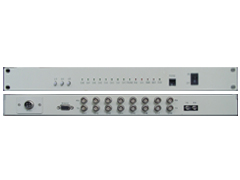Home » 121805. 8E1+100M PDH Multiplexer
Categories
News
Our newsletter
121805. 8E1+100M PDH Multiplexer
PDH optical multiplexer is a kind of point-to-point optical transmission equipment developed by our company on the core of large-scale integrated circuit chips. It is applicable to remote transmission of switches, and small/medium-capacity applications transmitted over fibers, including mobile communication base stations, wireless local communication base stations and paging stations. The equipment features perfect overall performance, stable and reliable operation, low power consumption, high integration, small size and easy installation and maintenance. It is intended for carries and such fields as post and telecommunications, electrical power, railway, water resources, oilfields, and banks.
Detailed description
Product Features:
- ZBC-CLINK120A adopts two integrated media converter modules operating in active/standby mode (optional);
- Providing 8 E1 (2.048KB/S) interfaces and one wire speed 10/100M adaptive Ethernet interface;
- Full duplex/half-duplex adaptive operating mode;
- Full digital clock recovery and smooth phase lock technology;
- The code pattern of the E1 interfaces is HDB3 code, and the E1 jitter tolerance, transfer characteristic and output jitter completely meet the ITU-T G.703, G.823 and G.742 protocol.
- One PCM, without occupying 2M channel for transmission;
- Providing a user RS232 transparent data channel, and supporting unified network management;
- Providing perfect alarm and indication signals as well as alarm mask functions, using LED to display local and remote alarms and general alarms, capable of controlling remote loop back;
- Ensuring a transmission distance of over 40 km without relay;
- Board-level design for the integrated equipment, featuring high reliability and stable performance;
- Optional 220V AC power supply or -48V DC power supply.
Specification:
|
Parameter
|
Specifications
|
|
E1 interface
|
In compliance with ITU-T G.703/G.704 protocol
Rate: 2.048Mb/s; code pattern: HDB3
Interface impedance: 75ヘ BNC interface (unbalanced)/ 120ヘ RJ45 interface (balanced)
Permitted input frequency shift: 2.048MHz 【100PPM
Jitter characteristic: In compliance with ITU-T G.703/G.704 protocol
|
|
Optical interface
|
Wavelength: Single mode 1310 nm (optional 1550 nm)
Transmitting power: -10dBm/-5dBm (to be specified in order) Receiving sensitivity: Better than -36dBm (BER < 10-11)
Connector: FC
|
|
Ethernet Interface
|
In compliance with IEEE802.3/IEEE802.3u standard, using standard RJ45 connector
Supporting wire-speed 10Base-T/100Base-TX, full duplex/half-duplex adaptive mode
Supporting automatic crossover of twisted pairs
|
|
RS232 interface
|
One RS232 interface for use of the NMS, at the rate of 9600 bit/s, in DCE mode
One RS232 interface for use of user; at the rate of 300--19.2 Kbit/s, adaptive, in DTE mode Both RS232 interfaces share the same DB9 connector |
|
Order wire phone
|
The order wire phone is a common telephone set (two-wire phone), without occupying any E1 channel;
In the case of hook-off at the local end, ringing tone will be generated at the remote end, and ring back tone will be heard at the local end. If one party hooks on, the other party will hear busy tone. After the peer party hooks on, if the party at the local end does not hook on in 90 seconds, a kind of howler tone will be generated. |
|
Audio channel
|
Compression rate: A law in ITU G.711
Impedance: 600ヘ (balanced)
Audio range: 300Hz---3400Hz
Return loss: Not less than 18 dB
|
|
Power
|
Capable of dual power supply, mutual hot backup
AC 220V: 220V (AC) input, allowing 175V~264V (AC)
DC -48V: -48V (DC) input, allowing -40V~-60V (DC)
|
|
Power Consumption
|
< 10W
|
|
Operating Environment
|
Operating temperature 0~55ìC
Relative humidity: ÷95% (at 25ìC) |
|
Dimensions
|
483 mm (L)*44.5 mm (W)*220 mm (H)
|
Related products More»
- Home - About us - New Products - Download - News - Privacy - Contact us - Sitemap
- Powered by semcms 4.5 Copyright @ 2009 - 2025 Sevis Technology Limited.


 STL
STL 











